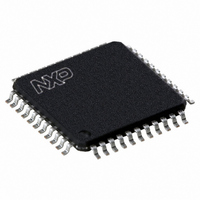P89V662FBC,557 NXP Semiconductors, P89V662FBC,557 Datasheet - Page 47

P89V662FBC,557
Manufacturer Part Number
P89V662FBC,557
Description
IC 80C51 MCU FLASH 32K 44-TQFP
Manufacturer
NXP Semiconductors
Series
89Vr
Datasheet
1.P89V660FBC557.pdf
(89 pages)
Specifications of P89V662FBC,557
Program Memory Type
FLASH
Program Memory Size
32KB (32K x 8)
Package / Case
44-TQFP
Core Processor
8051
Core Size
8-Bit
Speed
40MHz
Connectivity
I²C, SPI, UART/USART
Peripherals
POR, PWM, WDT
Number Of I /o
36
Ram Size
1K x 8
Voltage - Supply (vcc/vdd)
4.5 V ~ 5.5 V
Oscillator Type
Internal
Operating Temperature
-40°C ~ 85°C
Processor Series
P89V6x
Core
80C51
Data Bus Width
8 bit
Data Ram Size
1 KB
Interface Type
I2C/UART
Maximum Clock Frequency
40 MHz
Number Of Programmable I/os
36
Number Of Timers
3
Operating Supply Voltage
4.5 V to 5.5 V
Maximum Operating Temperature
+ 85 C
Mounting Style
SMD/SMT
3rd Party Development Tools
PK51, CA51, A51, ULINK2
Minimum Operating Temperature
- 40 C
Lead Free Status / RoHS Status
Lead free / RoHS Compliant
For Use With
622-1001 - USB IN-CIRCUIT PROG 80C51ISP
Eeprom Size
-
Data Converters
-
Lead Free Status / Rohs Status
Lead free / RoHS Compliant
Other names
568-2435
935280832557
P89V662FBC
935280832557
P89V662FBC
Available stocks
Company
Part Number
Manufacturer
Quantity
Price
Company:
Part Number:
P89V662FBC,557
Manufacturer:
Maxim
Quantity:
260
Company:
Part Number:
P89V662FBC,557
Manufacturer:
NXP Semiconductors
Quantity:
10 000
NXP Semiconductors
P89V660_662_664_3
Product data sheet
6.6.4 Baud rate generator mode
Bits TCLK and/or RCLK in T2CON allow the UART) transmit and receive baud rates to be
derived from either Timer 1 or Timer 2 (See
Timer 1 is used as the UART transmit baud rate generator. When TCLK = 1, Timer 2 is
used as the UART transmit baud rate generator. RCLK has the same effect for the UART
receive baud rate. With these two bits, the serial port can have different receive and
transmit baud rates – Timer 1 or Timer 2.
Figure 21
The baud rate generation mode is like the auto-reload mode, when a rollover in TH2
causes the Timer 2 registers to be reloaded with the 16-bit value in registers RCAP2H and
RCAP2L, which are preset by software.
The baud rates in modes 1 and 3 are determined by Timer 2’s overflow rate given below:
The timer can be configured for either ‘timer’ or ‘counter’ operation. In many applications,
it is configured for ‘timer' operation (C/T2 = 0). Timer operation is different for Timer 2
when it is being used as a baud rate generator.
Usually, as a timer it would increment every machine cycle (i.e.,
frequency). As a baud rate generator, it increments at the oscillator frequency. Thus the
baud rate formula is as follows:
Where: (RCAP2H, RCAP2L) = The content of RCAP2H and RCAP2L taken as a 16-bit
unsigned integer.
The Timer 2 as a baud rate generator mode is valid only if RCLK and/or TCLK = 1 in
T2CON register. Note that a rollover in TH2 does not set TF2, and will not generate an
interrupt. Thus, the Timer 2 interrupt does not have to be disabled when Timer 2 is in the
----------------------------------------------------------------------------------------------- -
16
Fig 21. Timer 2 in Baud Rate Generator mode
Modes 1 and 3 Baud Rates = Timer 2 Overflow Rate / 16
Modes 1 and 3 Baud Rates =
T2 pin
OSC
65536 RCAP2H RCAP2L
OscillatorFrequency
shows Timer 2 in baud rate generator mode:
T2EX pin
–
2
transition
detector
Rev. 03 — 10 November 2008
C/T2 = 0
C/T2 = 1
EXEN2
80C51 with 512 B/1 kB/2 kB RAM, dual I
control
TR2
control
Section 6.7
EXF2
RCAP2L RCAP2H
(8-bits)
timer 2
interrupt
P89V660/662/664
TL2
for details). When TCLK = 0,
(8-bits)
TH2
reload
1
6
the oscillator
© NXP B.V. 2008. All rights reserved.
TX/RX baud rate
002aaa526
2
C-bus, SPI
47 of 89
(3)
















